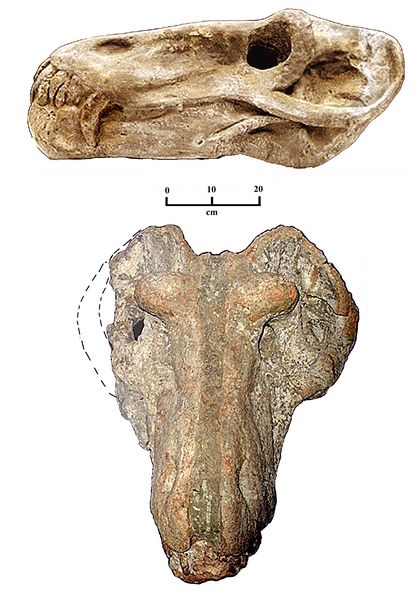Athena Review Image Archive ™
Anteosaurus magnificus skull

Anteosaurus magnificus skull (Top: Field Mus.Nat Hist.)
Anteosaurus magnificus is an extinct genus of large carnivorous synapsids from South Africa, dating from the Middle Permian period, during the Capitanien epoch of the Guadelupian stage (266-261 mya). Anteosaurus means “Antaeus reptile.”
During the Permian, two clades of amniotes came to dominate terrestrial niches: the sauropsids and the synapsids. The synapsids included top predators, such as Dimetrodoon and Gorgonopsia. Anteosaurus were therapsids, a clade within Synapsida that includes the Permian ancestors of mammals. They are further classified as dinocephalians, a group of large-bodied therapsids (or "mammal-like reptiles") that flourished from 270 to 260 million years ago and then went extinct without descendants.
Anteosaurus magnificus
was discovered in 1921 by Watson. At present over thirty skulls and
many skeleton fragments have been found. Based on its body form of
a strong tail and weak, sprawling legs, Anteosaurus
probably lived in rivers and hunted like crocodiles. It body
length was 5-6 m (16-20 feet), making it one of the largest known
therapsid carnivores. Thickened skull ridges over the eyes and
snout suggest it engaged in strong head-pushing or -butting. The skull
length is 80 cm (about 2 1/2 feet). Teeth on the roof of the mouth
are enlarged and confined in a cluster near the outer tooth row,
including incisors, large canine teeth, and about ten cheek teeth.
The front of the mouth curves up due to the premaxillary bone of the
upper jaw.
References:
Kammerer, C. F. (2011). "Systematics of the Anteosauria (Therapsida: Dinocephalia)". Journal of Systematic Palaeontology. 9(2), 261-304.
Copyright © 1996-2020 Rust Family Foundation (All Rights Reserved).